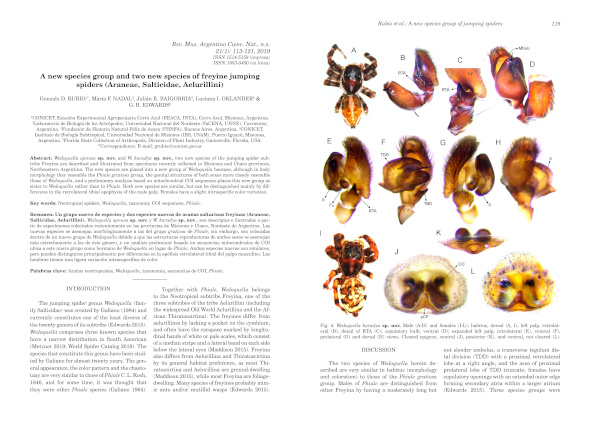A new species group and two new species of freyine jumping spiders (Araneae, Salticidae, Aelurillini)
Palabras clave:
Neotropical spiders, Wedoquella, taxonomy, COI sequences, PhialeResumen
Wedoquella apnnea sp. nov. and W. karadya sp. nov., two new species of the jumping spider subtribe Freyina are described and illustrated from specimens recently collected in Misiones and Chaco provinces, Northeastern Argentina. The new species are placed into a new group of Wedoquella because, although in body morphology they resemble the Phiale gratiosa group, the genital structures of both sexes more closely resemble those of Wedoquella, and a preliminary analysis based on mitochondrial COI sequences places this new group as sister to Wedoquella rather than to Phiale. Both new species are similar, but can be distinguished mainly by differences in the retrolateral tibial apophysis of the male palp. Females have a slight intraspecific color variation.Descargas
Referencias
Edgar, R.C. 2004. MUSCLE: multiple sequence alignment with high accuracy and high throughput. Nucleic Acids Research 32: 1792-1797. pmid:15034147
Edwards, G.B. 2015. Freyinae, a major new subfamily of Neotropical jumping spiders (Araneae: Salticidae). Zootaxa 4036(1): 1-87. doi.org/10.11646/zootaxa.4036.1.1
Felsenstein, J. 1985. Confidence limits on phylogenies: An approach using the bootstrap. Evolution 39: 783-791.
Folmer, O., Hoeh, W.R., Black, M.B. & R.C. Vrijenhoek. 1994. Conserved primers for PCR amplification of mitochondrial DNA from different invertebrate phyla. Molecular Marine Biology and Biotechnology 3: 294-299.
Galiano, M.E. 1981a. Revisión del genero Phiale C. L. Koch, 1846 (Araneae, Salticidae) III. Las especies polimórficas del grupo mimica. Journal of Arachnology 9: 61-85.
Galiano, M.E. 1981b. Revision of the genus Phiale C. L. Koch, 1846 (Araneae, Salticidae). IV. The polymorphic species of the gratiosa group. Bulletin of the British Arachnological Society 5: 205-216.
Galiano, M.E. 1984. Descripción de Wedoquella nuevo género (Araneae, Salticidae). Journal of Arachnology 11: 343-352.
Ivanova, N.V., Dewaard, J.R. & P.D.N. Hebert. 2006. An inexpensive automation-friendly protocol for recovering high-quality DNA. Molecular Ecology Notes 6(4): 998-1002.
Kimura, M. 1980. A simple method for estimating evolutionary rate of base substitutions through comparative studies of nucleotide sequences. Journal of Molecular Evolution 16: 111-120.
Koch, C.L. 1846. Die Arachniden. Dreizehnter Band, Nürnberg.
Kumar, S., Stecher, G., Li, M., Knyaz, C. & K. Tamura. 2018. MEGA X: Molecular Evolutionary Genetics Analysis across computing platforms. Molecular Biology and Evolution 35: 1547-1549.
Levi, H.W. 1965. Techniques for the study of spider genitalia. Psyche 72: 152-158.
Maddison, W.P. 2015. A phylogenetic classification of jumping spiders (Araneae: Salticidae). Journal of Arachnology 43(3): 231-292. doi.org/10.1636/arac-43-03-231-292
Peckham, G.W. & E.G. Peckham. 1896. Spiders of the family Attidae from Central America and Mexico. Occasional papers of the Natural History Society of Wisconsin 3: 1-101.
Saitou, N. & M. Nei. 1987. The neighbor-joining method: A new method for reconstructing phylogenetic trees. Molecular Biology and Evolution 4: 406-425.
Tamura, K. & M. Nei. 1993. Estimation of the number of nucleotide substitutions in the control region of mitochondrial DNA in humans and chimpanzees. Molecular Biology and Evolution 10: 512-526.
Wilson, J.J. 2012. DNA barcodes for insects. In Kress W.J. & D.L. Erickson (eds.). DNA barcodes: Methods and protocols, pp. 17-46, Springer.

Descargas
Publicado
Número
Sección
Licencia
Los autores/as que publiquen en esta revista aceptan las siguientes condiciones:- Los autores/as conservan los derechos de autor y ceden a la revista el derecho de la primera publicación, con el trabajo registrado con la licencia de atribución de Creative Commons, que permite a terceros utilizar lo publicado siempre que mencionen la autoría del trabajo y a la primera publicación en esta revista.
- Se permite y recomienda a los autores/as a publicar su trabajo en Internet (por ejemplo en páginas institucionales o personales), ya que puede conducir a a una mayor y más rápida difusión del trabajo publicado.
